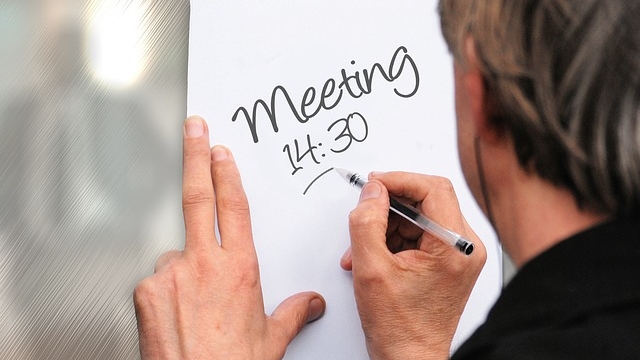Conferences are an excellent opportunity to network, learn, and interact with a specific industry or field.
But for a newbie on the scene, these larger than life mingling events can be overwhelming, and with so much going on in such a short period of time prioritizing and time management are key. Not too long ago, I was a conference new goer, and have since been around the circuit enough times to considered myself a seasoned pro. As I started attended more and more conferences, I began to perfect the art of conference going and preparation. Suffice it to say, the key to a successful conference is in the prep work.
So for all of you conference first-timers, or anyone who’s still new to the scene here is my breakdown of some important conference preparation steps:
STEP ONE: Do Your Research

An important element to a successful conference is research. A conference’s average lifespan typically averages anywhere from 2-3 days, and the attendee list often ranges in the thousands, depending on the event. This means you only have a few short days to make connections, shake hands, and gather information. Luckily, most of the major conferences publish attendee and exhibitor lists at least a month before the actual event takes place. These lists are a great place to start mapping out your trip. Scan through the list of companies attending, and start taking notes. Who is on your “Must Meet” list? Who do you want to exchange business cards with? Which companies are exhibiting at a booth, and which are there to walk around and network?
The purpose of this step is to filter out the contacts and companies you don’t necessarily need to connect with, and to single out the ones you can’t go home without meeting. As you go through the list, you’ll begin to notice that a handful of attendees are not on your watchlist, which will definitely help make networking seem a lot less daunting. Bare in mind, however, that one of the best parts of a conference is making that unexpected connection while you’re standing in line to refill on caffeine. Regardless of who made it onto your connection list or not, keep an open mind and be sure to keep those business cards flowing.
STEP TWO: Fill Up That Schedule
Once you’ve got the list of people and companies you want to meet in order, it’s time to start scheduling meetings. My suggestion is to start off by connecting with the companies who are at the top of your priority list and work your way down. LinkedIn is a great way to get in touch with the relevant contact in a particular company. I’ve found that when booking meetings it’s always better to reach out to a specific individual, as opposed to sending a message via a contact form or inquiry email. Your emails should first introduce yourself and your business, as well as explain the reason why you are reaching out to the company and contact. Keep in mind that the people you want to meet also have a priority list of their own, and their time at the conference is just as limited as your is. The key to booking meetings is to get the right message across in an email. In just a few short lines, the person reading your email should understand who you are, what you do, and why it’s worth it for them to meet with you. Not every company attending the same conference offers the same services or works in the same field so be sure to customize your emails accordingly, so that you don’t come off sounding too generic or vague.
In my time spent at conferences, I’ve also learnt that it’s best to only book meetings with companies who aren’t exhibiting at a booth or table. Set aside a slot of time to stroll down the aisles of the exhibition hall, and meet the companies displaying at booths then. Those meetings typically only take about 5-10 minutes so you can accomplish a lot in a short period of time if you know which booths you want to hit. These booths typically have 2 or more employees manning the station, so you shouldn’t have a problem getting connected to the right individual, or swapping cards with someone who can put you in touch with the relevant contact.
STEP THREE: Get Yourself Noticed
In this day an age, social media plays a big role in the conference world. Most conferences have social media pages and groups, which are open to attendees. This is a great way to connect with conference goers and get noticed. Be sure to join the groups, and visit the pages. Skim through the list of members and keep an eye out for anyone who might prove to be a good, new connection. Feel free to post comments, or questions on group pages. These social media platforms are meant to help you prepare for the conference, and in my experience, the community of of members is always eager to help out a new timer.
While you’re getting yourself noticed on the social media scene, be sure to publish your travel itinerary in other locations. Post about your conference plans on your website, and let people know that you’re booking meetings. You never know who might read the post and reach out to connect!
STEP FOUR: Build a Cheat Sheet
Your schedule will most likely start to fill up as the conference gets closer. Once you’ve got most of your meetings confirmed I suggest you start building yourself a cheat sheet. Most conferences take place in big venues, and there are plenty of faces and names moving around. While you have probably confirmed most of your meeting times and places, it’s good to keep all of your contact information organized on a cheat sheet. Organize your cheat sheet in the order of your meetings. Here’s a suggestion for important notes to keep on your cheat sheet:
– Meeting With: ____________________ – Company: _______________________ – Position: ________________________ – Meeting Place: ___________________ – Meeting Time: ____________________ – Cell: ____________________________ – Email: ___________________________ – Talking Points: ____________________ |
I like to keep a photo of the person I’m meeting with on file. Conferences are typically very crowded, so having photo references of the people you should keep an eye out for typically helps save time and energy. I also strongly suggest that you keep a cell or contact number on file. Anything goes during conferences, and meetings typically run long, get delayed, or cancelled at a moments notice. By being equipped with contact numbers you can quickly shoot over a text to let your meeting know you’re running late, or agree to reschedule for a different time. Phone numbers also often help to find people in a crowd!
STEP FIVE: Scope Out The Space
Conferences tend to get very crowded very fast and it’s easy to get a little disoriented once things get going. Try scoping out the conference area before things start up so you know exactly what’s going on. If you haven’t planned out a specific location for your meetings, now is a good time to do so. While the conference venue is still quiet, you can scope out the best place to make your new connections. Decide on a spot that’s easy to find and access and email the people you’re meeting ahead of time regarding the location of the meeting. This is a great way to save time and avoid any confusion.
Now that you’re prepped and ready to go, it’s time to start connecting. Be sure to have your business cards in hand, and be prepared with your elevator pitch. I like to take a permanent maker with me while I’m walking through the conference venue. Business cards get swapped at a moments notice, and I always like to jot down a note or two on the business card so that I know what the card is in reference to once the conference is over.
Ultimately the key to a successful conference is a positive and friendly attitude, and an open mind. If you plan properly and come prepared there is no limit to the amount of opportunities that can come out of a conference.
Have Fun & Good Luck!
Written by our Business Development Director Leytal Ross




